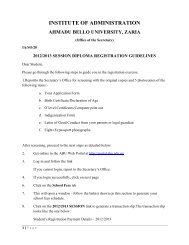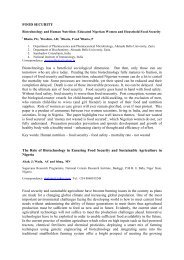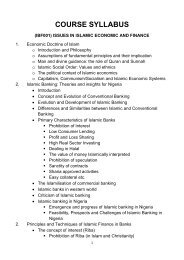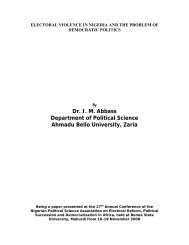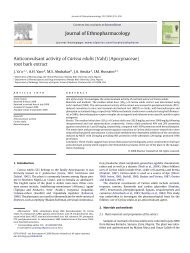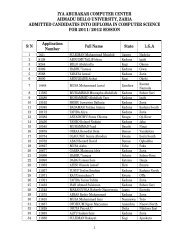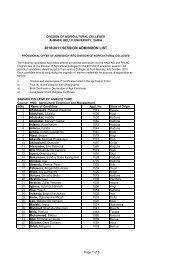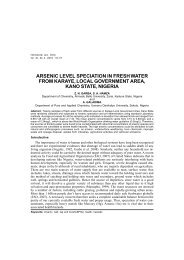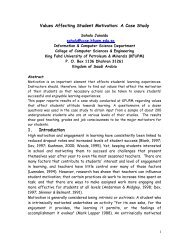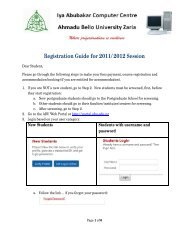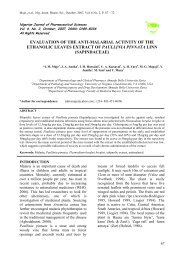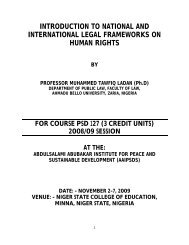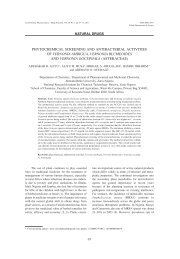Full Paper [PDF]
Full Paper [PDF]
Full Paper [PDF]
Create successful ePaper yourself
Turn your PDF publications into a flip-book with our unique Google optimized e-Paper software.
Gbolade et al., Nig. Journ. Pharm. Sci., March, 2011, Vol. 10 No. 1, P. 39 – 49Nigerian Journal of Pharmaceutical SciencesVol. 10, No.1, March, 2011, ISSN: 0189-823XAll Rights ReservedANTI-HYPERGLYCAEMIC AND HYPOLIPIDEMIC ACTIVITIES OF STEMBARK ETHANOL EXTRACT OF SPONDIAS MOMBIN L. (ANACARDIACEAE)1 Gbolade, A. A., 2 Akinlolu, A. A and 3 Odewabi, A. O.1 Department of Pharmacognosy, Faculty of Pharmacy, Olabisi Onabanjo University, Sagamu campus, OgunState, Nigeria2 Department of Anatomy, Faculty of Basic Medical Sciences, Olabisi Onabanjo University, Ikenne campus,Ogun State, Nigeria3 Department of Chemical Pathology, Olabisi Onabanjo University Teaching Hospital, Sagamu campus, OgunState, Nigeria1 Current address: Department of Pharmacognosy, Faculty of Pharmacy, University of Benin, Benin City,Nigeria*Author for Correspondence: adegbolade@yahoo.com (A. A. Gbolade)ABSTRACTEthanol extract of Spondias mombin L. (Anacardiaceae) stem bark was investigated for effects onhyperglycaemia, hyperlipidemia, liver and kidney functions, and toxicity to various body organs after chronicdaily administration at 150 mg/kg and 400 mg/kg to alloxanised rats for 4 weeks. A significant decrease(P
Gbolade et al., Nig. Journ. Pharm. Sci., March, 2011, Vol. 10 No. 1, P. 39 – 492005) with the goal of reducing theincreased low density lipoprotein (LDL)and triglyceride, and to increase thedecreased high density lipoprotein (HDL).Altered lipids and lipoprotein metabolismin chronic diabetes mellitus is associatedwith pathogenesis of atherosclerosis andother cardiovascular diseases (Manninen,et al, 1992). Abnormalities in plasmalipids and lipoprotein patterns due todefect in insulin insufficiency has beenwell documented, in both type I and type IIdiabetes mellitus (Das and Mohen, 2003).Spondias mombin L. (Anacardiaceae) is atree up to 20 m, widespread in farmlandsand growing easily from stakes for makingfence and enclosures (Burkill, 1985). It is anative of Caribbean and tropical America,but is now naturalized in West Africa. S.mombin is traditionally employed as apurgative, anthelmintic, analgesic,haemostatic and remedy for cough andgonorrhoea (Burkill, 1985). A wide varietyof biological activities such as abortificient(Offiah and Anyanwu, 1989), anti-anaemic(Adeyemi and Gbolade, 2006) and otherbiological activities (Corthout, et al, 1988;Corthout, et al, 1994) have beendocumented for S. mombin. The plant isalso included in antidiabetic/antihyperglycaemic herbal remedies in arecent ethnobotanical survey of southwestern Nigeria (Gbolade, 2009).Prominent among the chemicalconstituents of the plant are the phenoliccompounds, gallotannins and phenolicacids (Corthout, et al, 1988; Corthout, etal, 1994).A large number of traditional medicinalplants are still being used to treat diabetesmellitus (Alarcon-Aguilara, et al, 1998)and research into antidiabetic potential ofother plants is continuing. S. mombin isone of such plants shown to possessantidiabetic property in a preliminaryinvestigation by Gbolade, et al (2008).Fred-Jaiyesimi, et al (2009) identifiedantidiabetic principle in S. mombin as analkane derivative. In continuation of ourearlier study, we examined the effects ofchronic administration of the ethanolextract of the plant on various organs, liverand kidney functions, and hyperlipidemiaon alloxan diabetic rats.MATERIALS AND METHODSPlant materialFresh samples of S. mombin (commonname: hog plum) stem bark were collectedfrom Olabisi Onabanjo UniversityTeaching Hospital (OOUTH) premises inFebruary 2008, Ogun State andauthenticated by Mr. K. Odewo at theherbarium of the Forestry ResearchInstitute of Nigeria (FRIN), Ibadan(voucher no: FHI 106132). Plant materialwas cut into pieces, sun dried at ambienttemperature and ground into coarsepowder using a milling machine.Powdered bark (500g) were maceratedwith 95% v/v ethanol for a week, filteredand the filterate concentrated to dryness invacuo to yield a residue, 30.1 g (4.3%).Experimental AnimalsAlbino rats of both sexes weighingbetween 100-210 g were obtained from thecolony breed of the animal house of theUniversity of Ibadan, Ibadan, Oyo state.The rats were kept in cages at the animalhouse of Faculty of Pharmacy understandard conditions and fed with standarddiet (Growers feed) and water ad libitum.These normoglycaemic rats were dividedinto five groups (A-E) of five animalseach.Ethical clearanceThe experiment was performed with thepermission of the University’s AnimalEthical Committee, and in accordance withapproved institutional and nationalguidelines for the care and use oflaboratory animals. All experiments onanimals were in accordance with the40
Gbolade et al., Nig. Journ. Pharm. Sci., March, 2011, Vol. 10 No. 1, P. 39 – 49guidelines of both the Committee and theInternational Guidelines for Handling ofLaboratory Animals (Derrell, 1996). Theauthors declare no conflicting interest inthis work.Anti-hyperglycaemic studiesAnimals were fasted for 18 h. (but allowedaccess to water) before induction ofhyperglycaemia, which was accomplishedby intraperitoneal injection of 150 mg/kgof alloxan monohydrate (BDH) accordingto Gbolade, et al (2008). Animals were fedad libitum 1 h. after alloxanisation. Fastingblood glucose (FBG) was monitoredbefore and after alloxanisation fromsamples collected by amputation of the tailtip under mild anaesthesia. The blood wasdropped onto dextrostix (Accu-Cheksystem, Roche Group, Germany) reagentpad and values read using the microprocessor digital blood glucometer,Glucotrend R 2 (Accu-Chek system, RocheGroup, Germany). The diabetic state of theanimals was assessed by FBGmeasurement 48 h. after alloxanisation,and rats with significant hyperglycaemiai.e. FBG beyond 150 mg/dl were selectedfor the study and divided into five groupsA-E of five animals each. Doses of 150mg/kg and 400 mg/kg b.w. of the ethanolextract were fed orally to separate groupsA and B rats respectively. Group Canimals received 100 mg/kgchlorpropamide (reference drug, positivecontrol) while normal saline (1 ml/kg) wasfed into both the negative alloxanisedcontrol group D and normoglycaemicgroup E. The FBG was monitored in allthese groups at 0 h. prior to treatment withtest agents, and after 1, 2, 3, 4 weeks ofadministration of a daily dose of theextract and control drugs (with feeding).Hypolipidemic studiesLipid parameters such as total plasmacholesterol and triglycerides weredetermined using appropriate standardRandox kit (Randox Laboratories Ltd.,Antrium, UK). Blood samples collectedfrom all treated rats after the 4 th week ofhypoglycaemic experimentation byamputation of the tail tip under mildanaesthesia were centrifuged at 4000 rpmfor 5 min to obtain the plasma. Theabsorbance of the solution obtained byadding 0.02 ml plasma to 2 ml appropriateRandox kit solution was read from theUNIC 2100 Spectrophotometer at 500 nm,and the concentration of either totalcholesterol or total triglyceridesdetermined by reference to theconcentration of the standard (200 mg/dl)(Manninen, et al, 1992).Toxicological studiesBlood samples were withdrawn from allgroups of animals after 4 weeks of antihyperglycaemicstudy and analyzed fortoxicological parameters relating to liverfunction (aspartate aminotransferase, ASTand alanine aminotransferase, ALT), renalfunction (serum urea) using Randoxenzyme kits (Randox Laboratories Ltd.,Antrium, UK) and a Spectrophotometer(UNICO S2100-Visible). Assessment ofhaematological indices (packed cellvolume, PCV and white blood cell count,WBC), differential white cell count forneutrophils, lymphocytes and eosinophilswere conducted as described byArambewela, et al (2005). After bloodwithdrawal, animals were sacrificed andweighed. The liver, kidney, heart, spleen,lungs, brain from two rats per group wereremoved, blotted free of blood andweighed relative to body weight. Theywere later preserved in formalin forhistological analysis according to Kieman(1990).Statistical analysesAll values in the test are presented asmean±SEM (standard error of mean).Statistical differences between the meansof the various groups were evaluated byone-way analysis of variance (ANOVA)using Proc GLM in SAS statisticalpackage [SAS Institute, North Carolina,41
Gbolade et al., Nig. Journ. Pharm. Sci., March, 2011, Vol. 10 No. 1, P. 39 – 49USA], and students’t-test. P values of 0.05or less were considered to be significant.RESULTSEffect on blood glucoseTable 1 shows the anti-hyperglycaemicactivity of S. mombin extract (defined aspercentage decrease in FBG relative topost induction values). The activity at 150mg/kg and 400 mg/kg, was significantlyhigher (P
Gbolade et al., Nig. Journ. Pharm. Sci., March, 2011, Vol. 10 No. 1, P. 39 – 49Table 1: Effect of Spondias mombin ethanol extract on blood glucose level (mg/dl) in alloxanised ratsTreatment Pre-induction Post-induction 1 st week 2 nd week 3 rd week 4 th weekGroup A, extract (150 mg/kg)59.2±4.2 309.8±28.9 228.8±27.4 a(-26.1%) b,c 148.2±27.4 a(-52.2%) b,c 98.6±9.9 a(-68.2%) b,c 55.8±5.9 a(-82%) b,cGroup B, extract (400 mg/kg)62.0±5.3 256.6±38.4 182.01±4.7 a 131.6±7.1 a 98.6±4.5 a 68.0±7.9 a(-29.1) b,c (-48.7%) b,c (-61.6%) b,c (-73.5%) b,cGroup C Chlorpropamide (100 mg/kg)55.2±4.5 221.6±17.9 179.2±18.5 a 151.2±17.7 a 128.0±18.3 a 97.6±19.4 a(-19.1%) b (-31.8%) b (-42.2) b (-56%) bGroup D, Alloxan + normal saline(1 ml/kg) 54.0±3.4 209.8±23.8 224.0±25.6(6.8%)244.6±26.5(16.6%)252.2±26.2(20.2%)270.6±26.6(29%)Group E,Normo-glycaemic(normal saline, 1 ml/kg) 57.4±2.6 - 55.2±3.3(-3.8%)The results are expressed in mean ± standard error of mean (S.E.M), n= 5The values in parenthesis represent % decrease (-) /increase (+) in blood glucose level post-inductiona = P
Gbolade et al., Nig. Journ. Pharm. Sci., March, 2011, Vol. 10 No. 1, P. 39 – 49Effect on lipid parametersAfter 4 weeks therapy with the extract, asignificant fall (P
Gbolade et al., Nig. Journ. Pharm. Sci., March, 2011, Vol. 10 No. 1, P. 39 – 49Table 3: Effect of Spondias mombin ethanol extract on organ weight on alloxanised ratstreated for 4 weeksTreatment Brainx10 -2 (g)Liverx10 -2 (g)Kidneyx10 -3 (g)Heartx10 -3 (g)Spleenx10 -3 (g)Lungx10 -3 (g)Group A,extract (150mg/kg) 1.00±1.1 c 2.86±2.7 b 6.00±4.5 c 3.68±3.3 3.96±1.6 b,c 9.10±3.3 a,bGroup B,extract (400mg/kg) 1.00±1.1 c 2.62±3.9 b 5.86±2.9 c 3.22±1.8 5.56±4.5 a,b,c 7.48±7.1Group CChlorpropamide(100 mg/kg) 1.44±3.7 a 3.38±2.5 7.84±6.8 a,b 4.04±4.3 7.38±1.3 a,b 8.48±4.5 a,bGroup D,Alloxan +normal saline (1ml/kg) 1.42±1.9 a 4.04±2.5 a 6.82±6.7 3.34±3.3 9.92±4.8 a 7.26±4.6Group E,Normoglycaemic(normal saline,1 ml/kg) 0.98±2.0 b 2.80±2.0 b 6.60±4.0 3.60±2.5 4.60±5.1 7.00±3.2The results are expressed in mean ± standard error of mean (S.E.M), n= 5a = P
Gbolade et al., Nig. Journ. Pharm. Sci., March, 2011, Vol. 10 No. 1, P. 39 – 49Table 4: Effect of Spondias mombin ethanol extract on liver and renal function test onalloxanised rats treated for 4 weeksTreatment AspartateaminotransferaseAlanineaminotransferateBlood urea(mg/dl)(AST) (Uml -1 ) (ALT) (Uml -1 )Group A, extract(150 mg/kg)19.7±1.6 c 28.0±2.3 c 39.9±1.4 a,b,cGroup B, extract(400 mg/kg) 16.6±1.2 c 21.1±4.1 c 28.7±0.9 bGroup CChlorpropamide(100 mg/kg) 39.7±3.1 a,b 38.0±5.7 a,b 25.0±1.2 bGroup D, Alloxan+ normal saline (1ml/kg) 22.0±1.8 c 23.4±1.2 c 52.2±3.3 a,cGroup E,Normo-glycaemic(normal saline, 1ml/kg) 20.4±1.5 c 16.7±2.7 c 27.3±2.4 bThe results are expressed in mean ± standard error of mean (S.E.M), n= 5a = P
Gbolade et al., Nig. Journ. Pharm. Sci., March, 2011, Vol. 10 No. 1, P. 39 – 49Effect on enzymes and haematologicalindicesAlloxanisation showed no significantchange in serum levels of ALT and ASTwhen compared with normoglycaemiccontrol (Table 4). Apart fromchlorpropamide which significantly(P
Gbolade et al., Nig. Journ. Pharm. Sci., March, 2011, Vol. 10 No. 1, P. 39 – 49isolated from S. mombin leaf was found tobe responsible for the anti-hyperglycaemicactivity (Fred-Jaiyesimi, et al, 2009).Other secondary metabolites were alsoreported to elicit anti-hyperglycaemicactivity in other plants (Gbolade, 2010).A close relationship which has beenestablished between diabetes andhyperlipidemia (Nagarajana, et al, 2005;Gbolade, et al, 2010) was furtherconfirmed by this investigation. The actionof the extract could strictly be described ashypotriglyceridemia, and is being reportedfor the first time. The mechanism ofhypolipidemic action has been linked withincreased utilization of glucose followingadministration of plant extracts therebydepressing mobilization of fat (Alarcon-Aguilara, et al, 1998; Gbolade, et al,2010). This shows that the extract wasmore effective in controlling triglycerideslevel and may serve as a preferred naturalproduct-hypolipidemic agent over thestandard antidiabetic drug. Investigationsby previous workers reportedhypolipidemic effect with respect to alllipid parameters for appropriate plants(Sharma, et al, 1996; Nagarajana, et al,2005; Gbolade, et al, 2010).Protection of the brain and liver againstdamage induced by alloxan (only threeorgans affected) by plant extract is ahallmark of anti-hyperglycaemic research,and this is consistent with the findings ofArambewela, et al (2005) on Piper betleleaf extract administered to streptozotocininduceddiabetic rats. The observedinsignificant changes in the indices of liverfunction are suggestive of hepatotoxicity.Recently, no overt signs of hepatotoxicityin terms of serum AST and ALT levels(Arambewela, et al, 2005), or renotoxicityas judged by serum urea and creatininewere indicated for appropriate plants.Hepatoprotective ability of Clemeo felinaby reference to other enzymes has alsobeen documented (Nagarajana, et al,2005). Control of haematologicalparameters with S. mombin extract may beof little value since they were notsignificantly altered (Arambewela, et al,2005) by alloxan.CONCLUSIONThe combined reduction in alloxaninducedhyperglycaemia andhyperlipidemia for the first time, by S.mombin stem bark ethanol extract after 4weeks therapy, suggests the plant topossess potential as an antihyperglycaemicagent of natural origin.The hepatoprotective action and protectionof other major organs, further lendcredence to the anti-hyperglycaemicpotential of the plant. The study alsoencourages investigation into other plantsources in the search for more effective,non-toxic and affordable antihyperglycaemicagents as substitutes forsynthetic agents.AcknowledgementsThe technical assistance from Mr. M. N.Ekor, Department of Pharmacology,Faculty of Basic Medical Sciences, OOUis gratefully appreciated.REFERENCEAdeyemi, A. A. and Gbolade, A. A.,(2006), Anti-anaemic effects of Spondiasmombin and Khaya grandifoliola aqueousextracts on rats. J. Pharm. Bioresour. 3,94-97.Alarcon-Aguilara, F. J., Roman-Ramos,R., Pesez-Gutierrez, S., Aguilar-Contreras,A., Contreras-Weber, C. and Flores-Saeuz,J. L., (1998), Study of the antihyperglycaemiceffects of plants used asantidiabetics. J. Ethnopharmacol. 61, 101-110.Alberti, K. G. and Zimmet, P. Z., (1998),New diagnostic criteria and classificationof diabetes-again? Diabetic Med. 15, 535-536.48
Gbolade et al., Nig. Journ. Pharm. Sci., March, 2011, Vol. 10 No. 1, P. 39 – 49Arambewela, L. S. R., Arawwawala, L. D.A. M. and Ratnasooriya, W. D., (2005),Antidiabetic activities of aqueous andethanolic extracts of Piper betle leaves inrats. J. Ethnopharmacol. 102, 239-245.Burkill, H. M., (1985), The Useful Plantsof West Tropical Africa, (Families A-D).2 nd Ed. Royal Botanic Gardens, London.Corthout, J., Pieters, L., Claeys, M.,Berghe, D. V. and Vlietinck, A. J., (1988),Antivirally active gallotannins fromSpondias mombin. Planta Med. 54, 573-576.Corthout, J., Pieters, L., Claeys, M.,Geerts, S., Vanden-Berghe, D. andVlietinck, A., (1994), Antibacterial andmolluscicidal phenolic acids fromSpondias mombin. Planta Med. 60, 460-463.Das, S. and Mohan, V., (2003), Disordersof Lipid Metabolism. In API Text Book ofMedicine. 75 th Ed. Association ofPhysicians of India, Mumbai, p. 250-258.Derrell, C., (1996), Guide for the Care andUse of Laboratory Animals. Institute ofLaboratory Animal Resources. NationalAcademy Press, Washington DC, USA.Fred-Jaiyesimi, A., Abo, K. and Wilkins,R., (2009), α-Amylase inhibitory effect of3β-olean-12-en-3-yl (9Z)-hexadec-9-enoate isolated from Spondias mombinleaf. Food Chem. 116, 285-288.Gbolade, A. A., Ekor, M. N., Akinlolu, A.A. and Ayoola, M. D., (2008),Antidiabetic activity of stem barkethanolic extracts of Spondias mombin onalloxan-induced diabetic rats. J.Pharmaceut. Res. 7, 192–195.Gbolade, A. A., (2009), Inventory ofantidiabetic plants in selected districts ofLagos State, Nigeria. J. Ethnopharmacol.121,135-139.Gbolade, A. A., (2010), Antidiabeticplants of Nigeria. Inventirapid:ethnopharmacol. (in press).Gbolade, A. A., Adeyemi, A. A. andOyebadejo, T. Y. (2010),Antihyperglycaemic and hypolipidemicstudies of three medicinal plants onalloxan-induced diabetic rats. J.Pharmaceut. Res. 9, 81-86.Kieman, J. K. (1990), Histology andHistological Methods, Theory andPractice. 2 nd Ed. Pergamon press, Exeter.Manninen, V., Tenkanen, L. andKoskinien, P., (1992), Joint effects ofserum triglycerides and LDL cholesteroland HDL cholesterol concentrations oncoronary heart disease risk in the Helsinkiheart study: implications for treatment.Circulation 85, 37-45.Nagarajana, N. S., Murugeshb, N.,Thirupathy-Kumaresanc, P., Radhad, N.and Muralid, A., (2005), Antidiabetic andantihyperlipemic effects of Clemeo feline.Fitoterapia 76, 310-315.Offiah, V. N. and Anyanwu, L. L., (1989),Abortificient activity of an aqueous extractof Spondias mombin leaves. J.Ethnopharmacol. 26, 317-320.Pepato, M. T., Baviera, A. M.,Vendramini, R. C., Perez, M. P., Kettelhut,I. C. and Brunetti, I. L., (2003), Cissussicyoides (Princess wine) in thelong term treatment of streptozotocindiabeticrats. Biotechnol. Applic. Biochem.37, 15-20.Sharma, S. R., Dwivedi, S. K., Varshney,V. P. and Swarup, D., (1996),Antihyperglycaemic and insulin releaseeffects of Aegle marmelos leaves instreptozotocin-diabetic rats. Phytother.Res. 10, 426-428.49


![Full Paper [PDF]](https://img.yumpu.com/49740055/1/500x640/full-paper-pdf.jpg)
